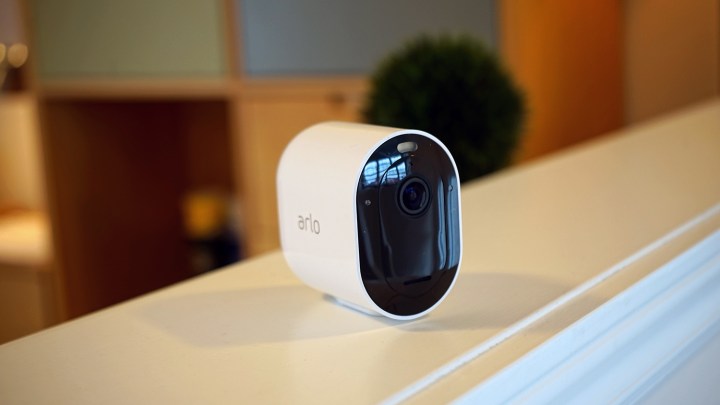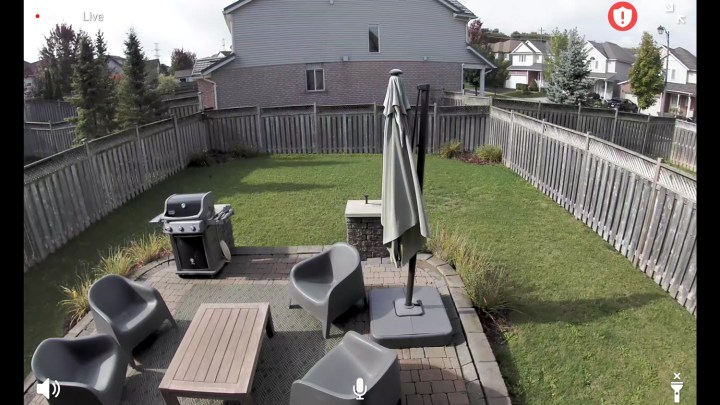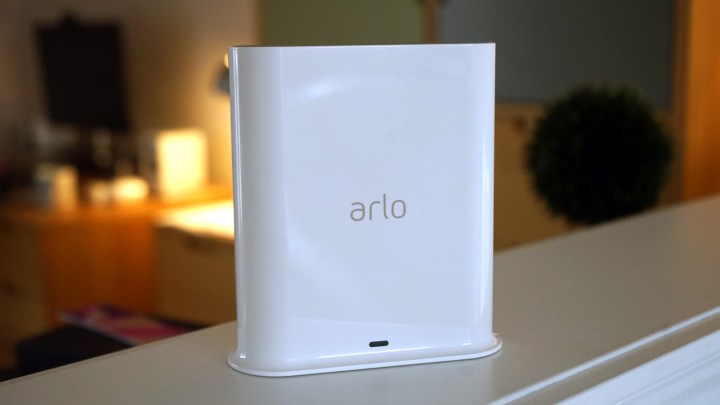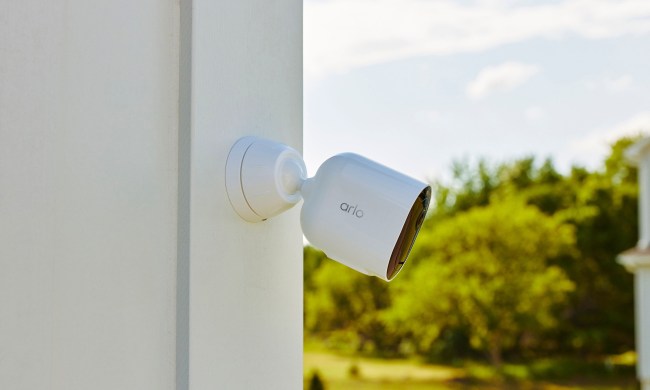- Weatherproof, wire-free cameras
- High quality 2K video
- Smart A.I. features
- Simple to install and use
- Easy upgrade for existing Arlo owners
- Minor performance issues with multiple 2K streams
- Advanced features require subscription
Since its early days as a quirky offshoot of Netgear, Arlo has found its rhythm with a superb selection of wire-free and weatherproof smart cams. The high-definition Arlo Pro 2 frequently toped our list of best outdoor security cameras, and it’s a competent choice for an indoor camera as well.
In April 2019, Arlo’s Ultra 4K arrived, marking the first shot fired in a next-generation battle for UHD smart cam supremacy. It boasts superior image clarity and impressively wide vistas, but a $300-per-camera price tag and a restrictive upgrade path for existing Arlo owners meant it wasn’t quite a slam dunk.
The Arlo Pro 3 (originally $500 for a 2-camera kit, with add-on cameras priced at $199 each) sits squarely between the two. While it lacks Arlo Ultra 4K’s headline-grabbing UHD resolution, it offers a broader suite of enhancements that make it — arguably — a better choice than Arlo’s priciest kit.
Even with all of the fierce competition in the space, Arlo’s outstanding track record has given consumers confidence that this one should continue to succeed. Its broad popularity has helped to spawn other recent entries such as the Arlo Pro 3 Floodlight, Arlo Essential, Arlo Essential Wireless Video Doorbell, and most recently its successor in the Arlo Pro 4. If that’s not enough, the company also released its indoor specific security camera, the Arlo Essential Indoor Security Camera, which is notable for the mechanical shutter it’s packing to respect your privacy.

This new model boosts image resolution ranging from the Arlo Pro 2’s 1080p to a sharper, more vibrant 2K (2560 x 1440 pixels) with support for high dynamic range (HDR), which promises better video quality in very dark or bright areas. A 160-degree field of view may be narrower than the Arlo Ultra 4K’s generous 180 degrees, but it’s a noticeable step up from the 130-degrees offered by the outgoing model.
Other features are lifted directly from the Arlo Ultra 4K. An integrated spotlight allows Arlo to claim support for color night vision, while noise-canceling two-way audio and an on-camera siren further reinforce the Arlo Pro 3’s security credentials. It also benefits from the neat magnetic charging system we met in April, which promises up to six months of camera battery life between charges.
A better choice for Arlo upgraders
Visually, the Arlo Pro 3’s cameras and supporting SmartHub look identical to those we encountered when reviewing the Arlo 4K Ultra. That’s not a bad thing as Arlo’s much-copied design is one of the more compact and attractive systems around. The curvy, all-plastic chassis is robust enough to weather the elements, while the installation is simplified by a strong magnetic mounting system (a screw-mounted option is also available). A partially flattened base also allows the camera to be placed indoors on a shelf or desktop. In short, you can install the Arlo Pro 3 anywhere.
Arlo’s much-copied design is one of the more compact and attractive systems around.
Also included here is Arlo’s latest SmartHub (VMB4540), which provides network connectivity between the cameras and your router. Again, it looks identical to the slimmer device introduced with the Arlo Ultra 4K, but a closer examination reveals important differences. External video storage for camera recordings is available, but on this model, it’s enabled by a single USB 2.0 port rather than the microSD slot equipped on the Arlo Ultra.
That’s good news for surveillance video hoarders, who will benefit from storage capacities up to 2 TB. The Arlo Pro 3’s lower-resolution video also allows the system to operate with reduced bandwidth requirements. This SmartHub operates on 802.11 b/g/n Wi-Fi rather than the faster “AC” standard supported on the Arlo Ultra 4K.

Perhaps the best news is that owners of some older Arlo systems can add Arlo Pro 3 cameras to their existing network and receive the benefit of enhanced 2K video streams without the need to replace their SmartHubs. That makes the Arlo Pro 3 a better upgrade option than Arlo’s top-tier kit. Arlo Pro 3 owners can even add Ultra 4K cameras to their systems at a later date, with no loss of functionality.
Setup’s a cinch
As was the case with every Arlo system we’ve reviewed, getting up and running with Arlo Pro 3 is really easy. Arlo recently introduced a new version of its smartphone app, which does a great job of guiding you through installation. Where cheaper smart camera systems can switch between direct Bluetooth and Wi-Fi connections during setup, Arlo’s wired SmartHub handles installation smoothly.
Hardware installation is equally simple, with screw and magnetic mounting options available in the box. Arlo’s newer, concave magnetic mount is fabulous, balancing strength and versatility. Cameras smartly snap to the mount at the rear and can be angled precisely, despite the firm connection. For more ambitious mounting, the included adjustable security mount can be screwed into walls, fences, ceilings, trees, and so on. It supports 360-degree rotation and 90-degree tilt.
A step up in video quality
In use, the Arlo Pro 3’s 2K image quality is a noticeable improvement over the previous-generation camera (and a huge leap from the 720p supported by the original Arlo system). While it doesn’t have quite the clarity you’ll get from Arlo Ultra 4K or wired Nest Cam IQ models, it’s still very good indeed.
The enhanced resolution allows you to take advantage of the camera’s 12x digital zoom without images immediately disintegrating into a blurry mess. Push beyond 3x zoom, though, and quality will noticeably degrade. Arlo Pro 3 is equipped with a smart Auto Zoom and Tracking feature, which is handy for security monitoring. Sadly, as we found with the Arlo Ultra 4K, when the feature is enabled, the camera’s resolution is dropped to 1080p.
Night vision provides greater sharpness and clarity than many competitors.
We found daytime image quality to be balanced, with accurate colors and good contrast. Arlo’s Auto HDR feature makes it one of the few smart cameras we’ve tested indoors that avoids overexposure near bright windows, which means you’ll capture images of anyone peering through your windows to see if you’re home. The 160-degree field of view is wide enough to cover all but the most expansive rooms or huge gardens, and fish-eye distortion is negligible.

At night, Arlo Pro 3’s color night vision feature requires the camera’s integrated spotlight to be illuminated. The resulting images are certainly more natural than the standard, spooky monochrome pictures produced by competitors. However, while range is good, color night vision suffers from the blurriness and noise typically associated with high ISO photography. With the spotlight disabled, the camera reverts to a standard night vision setting. Again, the illuminated range is good, and while monochrome images are also a little noisy, Arlo Pro 3’s night vision provides greater sharpness and clarity than many competitors.
Piercing alarm, integrated spotlight
While the Arlo Pro 3 isn’t necessarily competing with the likes of Simplisafe or Nest Secure as a full-fledged smart home security system, it’s equipped with several overlapping features that make it worth considering while we await the arrival of the upcoming Arlo Security System.
The piercing alarm from Arlo Pro 2’s SmartHub has been shifted to the cameras themselves, with an option to trigger when motion is detected. The resulting racket is certainly sufficient to scare off an intruder and, combined with the camera’s bright, integrated LED spotlight, it forms an effective first line of protection for your home.
The Arlo app supports a number of configurable modes to arm the system. Alongside a manual toggle, you can choose to enable monitoring using a timed schedule or geolocation setting. Each mode can be customized with simple IFTTT rules covering motion detection, video recording, and the integrated alarm, or you can quickly build a custom mode to fit your preferences. It’s all very simple.
Simple to use, but under the hood, it’s super smart.
Elsewhere, we found the updated Arlo app easy to get along with. There are only a few ways to tweak camera settings, but they include useful options like brightness, low-light settings, and video quality controls. Navigating, reviewing, and sharing video clips from the library is simple. A standard daily timeline view is ably assisted by filters that help users zoom in on the action from specific cameras, or review clips based on the type of alert triggered or object detected. Our only criticism with the app is that we found connecting to a camera’s livestream could take a while, even on the local network. On some occasions, we were viewing live video within 5 seconds. Other times, we’d experience a delay of up to 30 seconds.

With both cameras simultaneously livestreaming 2K video, we did see some temporary performance issues during stress tests. Every 20 seconds or so, both streams were replaced with a black screen for a second, before the livestream was restored. With 2K local streaming disabled, performance improved, although we continued to see a flicker once in a while. With both cameras reporting a good signal, we can only assume this was a network bandwidth issue or a processing bottleneck. Perhaps retaining Arlo Ultra’s 802.11ac connectivity would have been a better choice?
Intelligent features locked behind a paywall
While Nest often takes the plaudits for smart cam A.I., the Arlo Pro 3 is equipped with an admirable array of enhancements that add real convenience and utility. Sadly, most are locked behind an Arlo Smart subscription service, priced from $3 per month. A 3-month free trial is available on setup, so you can try out the features and see if the upgrade makes sense.
They include advanced object detection, which helps the camera to differentiate between people, vehicles, animals, and packages (the latter is currently in beta). Smoke and carbon dioxide alarm detection sends you a smartphone notification when a camera detects an audible alert. U.S. subscribers also get the benefit of an e911 feature, which allows you to call emergency services with a single tap on your smartphone.
We loved Arlo’s rich notification feature, which adds a thumbnail to the smart notifications sent to your phone. When a person is detected, you’ll see a frame captured by your camera. Many smart cams do the same, but Arlo also darkens the image and highlights the person in the frame. A quick glance and you can check whether the camera’s detected friend or foe. While it’s simple to use, Arlo is super smart under the hood. With everyday features like custom activity zones and 30 days cloud of video recording also included, Arlo Smart’s features work well. Only you can decide whether they’re worth the additional outlay.
Our take
While the Arlo Ultra 4K captured the headlines with its flashy UHD video resolution, we think the Arlo Pro 3 is a more worthy and economical successor to our favorite smart cam for the last two years, the Arlo Pro 2. It’s certainly not cheap, but Arlo Pro 3’s enhanced image quality, integrated security features, and simple app controls make it a fabulous choice for home surveillance. If you’re happy to invest in a monthly subscription, you’ll benefit from an extended suite of useful A.I. features that make the Arlo Pro 3 one of the smartest systems around. Meanwhile, owners of first- and second-generation Arlo systems have a reasonable path to upgrade their cameras and/or SmartHubs. We’ve been waiting for a competitive smart cam to knock Arlo Pro 2 off its perch — perhaps it was inevitable that the Arlo Pro 3 would do the job.
Is there a better alternative?
Few smart cameras offer Arlo’s winning blend of ease, quality, and versatility, but there are plenty of cheaper systems available if your budget is limited. The Swann Smart Security Camera ($129) is a solid budget pick, with similar wireless connectivity and weatherproof protection to Arlo, as well as 1080p HD imaging.
At the premium end of the market, the Arlo 4K Ultra ($599 for a 2-camera bundle) definitely beats the Arlo Pro 3 on video quality, but you should be aware you’ll need to invest in new cameras and a replacement SmartHub to take advantage of UHD video. It’s also worth noting that Arlo has expanded its line recently, introducing new models like the Arlo Pro 3 Floodlight and Arlo Essential. The Arlo Pro 4 is its successor, which ditches the need for the SmartHub because it now will diretly connect to a Wi-Fi network.
Elsewhere, Nest Cam IQ Outdoor ($399) and Nest Cam IQ Indoor cameras ($299) are accomplished top-tier performers that lack the Arlo Pro 3’s versatility and value.
How long will it last?
Arlo Pro 3 is built to withstand Mother Nature’s fierce temper, with operating temperatures between -4 Fahrenheit (-20 Celsius) and 113 degrees F (45 C), so expect the hardware to be robust. As for software, Arlo continues to release enhancements and tweaks for all Arlo systems, so we’d expect owners to enjoy a long and happy life with the Arlo Pro 3.
Should you buy it?
Yes. It’s an investment, but the Arlo Pro 3 is a fabulous choice for those considering their first smart home camera system.




